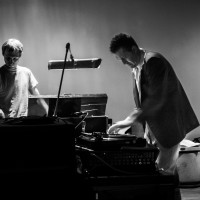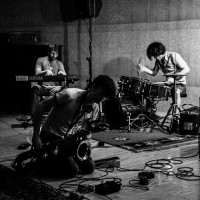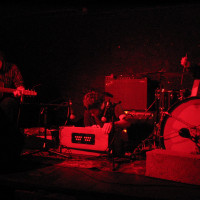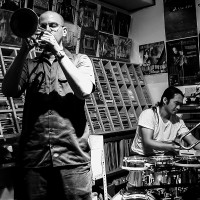
Real Estate VS Culture
The history of Williamsburg, a Brooklyn borough, is a series of incorporations. Founded in 1661 by a Dutch trade company, it was attached to Bushwick in 1827, then in 1855 to Brooklyn, which itself got swallowed by New York City as one of its five boroughs in 1898. Urban development always means shifts in the social and cultural fabric of an area, and Cisco Bradley maps what it has meant for the avant-garde music scene between 1988 and 2014.
The author, Cisco Bradley, an associate professor at the Pratt Institute, is a specialist of avant-garde music and the the founder of the www.jazzrightnow.com site. His impressive knowledge of the avant-garde music scene gives him the opportunity of creating a vivid written documentary that will allow the reader to understand why and how this district thrived musically. This is how he (accurately) describes his method in the introduction:
»The book relies on a combination of extensive ethnographic interviews, private archival collections, formal and informal music recordings, videos, photos and other ephemera.«
Starting in backrooms and warehouses, the scenes gradually moved up into art galleries and festivals, until they dissolved

The Williamsburg Avant-Garde is, actually, an atlas that can be read in at least three differeent ways: first, as a map of the various music movements that appeared in or moved to this area; also, as an archive of the locations where these musics were created, played or featured; finally, as a testimony of the fast urban changes that New York suburbs experienced with the still ongoing gentrification of traditionally blue-collar areas.
Divided in two parts, »Utopian Spaces for Sounds« and »Commercial DIY and the Last Underground Venues«, the book follows the story of real-estate development of the area and its impact on the music scenes. The first part focuses on the musical boom of Williamsburg in the late 1980s due to the soaring rent prices in New York City, and especially Manhattan, while the second part describes the consequences of the gentrification programs around 2004 until now.
A panorama of the music genres
What makes this book special is the deliberate choice Cisco Bradley made in composing its structure: Instead of a purely chronological description of the various musical genres which co-existed in Williamsburg at definite times, he has chosen to present them through the places they were either created or played. »My approach is to examine two related phenomena: art spaces and the communities that inhabit them,« Bradley explains in his introduction.
The Williamsburg Avant-Garde focuses thus a lot on locations and their importance in the cultural ecosystem of the various scenes. Not very surprisingly, music scenes generally evolve from the bottom up, and Williamsburg seems to be no exception. Starting in backrooms and warehouses, the scenes gradually moved up into art galleries and festivals, until they dissolved. The Lizard’s Tail was, for instance, such a place:
»One of the first underground venues that emerged in Williamsburg that was to give life to the music scene was The Lizard’s Tail, opened by an Irish-Belgian couple, Terry Dineen and Jean François Pottier, at 99th South Sixth Street, right under the Williamsburg bridge, in 1988, which they rented for $600 per month.«

Bradley is a master of using localization and precise references in order to set the frame in which new forms of music can develop. In the instance of The Lizard’s tail, Bradley writes:
»The Lizard’s Tail soon sparked a music scene in Williamsburg. (...) Antifolk, which shared certain aesthetics and sensibilities with punk and noise rock, found a home in the antiestablishment underground of Williamsburg.«

Bradley choses to link music history to the ecology of a city, and not only on its human actors
Bradley gives us an extensive panorama of the music genres that thrived in this period, from avant-rock, no wave, free jazz, to electronica and experimental, exposing the incredible vitality of the various scenes that often mixed and merged in special events, such as The Cat’s Head venue in the 1990s:
»At the first event, on July 14, 1990, they occupied an old mustard factory, where they built a thirty-two-foot stage, and Anna Hurwitz designed another stage backdrop similar to the one he had made for the Lizard’s Tail, though now involving six panels, each five feet by ten feet. It was a catalytic event for the music and arts community, and some have argued that this event marked the formal beginning of Williamsburg as a ‘scene’, drawing together many previously disconnected groups into one space.«
What Bradley does here is to remind us that creative music scenes cannot be separated from a geographical and architectural network that supports them. In other words, the Williamsburg scene existed because, like Paris in the 1920s, or London in the 1930s, there was a convergence of external factors that made it possible, such as low rents, more or less tolerant communities and a number of artists with the same goal or background. By following the development of these venues – when they opened, where they were located, when and why they closed – Bradley choses to link music history to the ecology of a city, and not only on its human actors.

At the same time, artists are named and their genre clearly mapped and defined, mostly though interviews, giving the book its documentary aspect. For example, under the chapter called »Grindcore Meets Free Jazz«, the reader will find this description of the still existing noise rock trio, Child Abuse:
»The first show ever held in the space that became Death by Audio featured the experimental grindcore band Child Abuse on March 31, 2007. (...) Child Abuse generally created music that was entirely composed, even though everyone involved had some kind of improvisatory practice in their other work. Dahl described the other members of the band as 'drawing from the oral tradition of music, not from an academic mindset or skill set. Our music is not notated, which allows it to mutate or to be malleable in ways that would not be possible in a more rigid system'.«
It is the most complete and satisfying book on the subject one can read
A crucial archival monument
The Williamsburg Avant-Garde is not only a remarkable book in its description and archiving of some of the most creative music movements in the 20th and 21st centuries, but is also an ominous reminder of the weight of economical factors in both the creation and the destruction of music and art scenes. As Bradley writes in his introduction:
»The digitization of music has also completely alienated musicians from the fruits of their labor and creativity as it can be so easily replicated, which has deflated the value that musicians are able to get from recordings. (...) But as theorist Adolfo Sanchez stated, ‘Under capitalism the artist tries to escape alienation, for alienated art is the very negation of art.’ Musicians have been on the losing side of this struggle for two decades now, and if left unchecked, it will continue to undermine the well-being of music communities.«

In many ways, The Williamsburg Avant-Garde is crucial archival monument to remember how and where creativity happens – and ultimately how it is killed by greed, just as it was in Paris and London, and many other metropolis in the world. In our society, art and music are unfortunately dependent on the economy, and at the bottom of the capitalistic food chain. As Bradley states at the end of his introduction:
»And during the last stages of writing this book, parts of the Bushwick scene have subsequently relocated eastward into Ridgewood, Queens. The voracious appetite of developers to further gentrify North Brooklyn has been stalled in recent times only by a global pandemic.«
To conclude, The Williamsburg Avant-Garde is a must read not only for avant-garde music aficionados, but for anybody interested in understanding how and why creativity bursts in some places at certain times. An excellent companion to Will Hermes’s Love Goes to Buildings on Fire: Five Years in New York That Changed Music Forever, it is the most complete and satisfying book on the subject one can read.
»The Williamsburg Avant-Garde«, by Cisco Bradley, Duke University Press.



